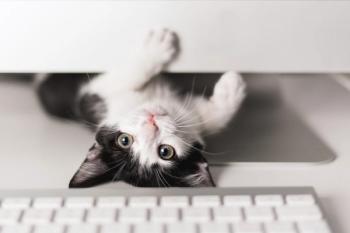
Veterinarian blends career with World War II history
Don Allen, DVM, cares for a cadever dog on the hunt for veterans' remains.
YOUNGSTOWN, OHIO — Don Allen, DVM, is not a typical veterinarian. Sure, he's operated a small animal practice for the past 20 years, but it's his obsession with history—specifically World War II history—that's added a whole new dimension to his career.
Allen graduated from the University of Illinois College of Veterinary Medicine in 1980, but it was a circuitous route that led him there—a route that included a stint in the Air Force, work as a farrier and a fascination with the Pacific theater.
"I've always loved animals," he says. "I started reading about World War II in junior high school. From then on I was hooked. After four years in the Air Force, I pursued my dream to become a vet and returned to college. The thought of working on a degree in history never occurred to me."
But history was always in the back of his mind and Allen became particularly interested in the Battle of Tarawa, a small atoll in the middle of the Pacific Ocean "about one degree above the equator, astride the International Date Line," he says.
Allen even took two trips to Tarawa, the capital of the Republic of Kiribati, while writing his book, Tarawa: The Aftermath, which was published in 2001.
Allen was drawn to the island again in February 2011, this time as a veterinarian. The idea for this visit began when Mark Noah, president of History Flight—a foundation committed to bringing home missing-in-action servicemen from their remote World War II burial sites—contacted Allen after visiting his website about Tarawa.
"I had just talked with a client about something called a 'cadaver dog,'" Allen says. "When Mark called, this was still fresh in my mind and I suggested the use of a cadaver dog on Tarawa. The dog sounded like a great idea to him."
Noah then contacted Paul Dostie, a retired Mammoth Falls, Calif., police investigator with a 7-year-old male black Lab, Buster. Dostie had adopted Buster as a puppy.
"I saw that he had great search potential," Dostie says. "I decided to train him as a cadaver dog because I specialized in homicide investigation at the Institute for Criminal Investigation. It seemed like a good fit."
Buster has a special talent that made him particularly well-suited for this venture, Allen says. Buster is trained to detect minute levels of organic compounds given off by 100-year-old bones. "I learned that older burials have the scent of bone decomposition, not soft tissue decomposition, and I trained Buster for that scent profile," Dostie says.
Dostie and Buster worked closely with Arpad Vass, PhD, at the Oak Ridge National Laboratory, "a renowned expert in human decomposition," Dostie says. "All of Buster's work is backed up by Dr. Vass with soil sample analysis on gas chromatography–mass spectrometry equipment."
Allen adds, "Dr. Vass has identified all the aromatic compounds given off by a body at various stages of decomposition. He even invented an electrical detector for some of these compounds and named his device 'the Labrador' in honor of Buster."
To train Buster on target odors, Dostie used the Behavior Shaping Device from Elite K9. "I obtain soil samples from known grave sites in ghost town cemeteries as training aids," he says. "These samples are usually 90 to 135 years old.
"Buster has a very high play drive and hunt drive," Dostie adds. "He was very easy to train."
Buster was trained and ready to go ahead of schedule, but Dostie refused to take him to a remote area without a veterinarian. Allen, with his previous Tarawa experience, was the perfect fit.
"I had two rock-solid conditions for going to Tarawa with Buster," Dostie says. "One was that there had to be a veterinarian with us the whole trip to take care of Buster if he became sick or injured. The other condition was that Buster would not ride in the cargo hold, but he would ride in the cabin with me. This was a real challenge on a non-U.S. airline, but Dr. Allen made it happen."
With Buster on board, Dostie and Allen headed to Tarawa with History Flight's Noah and a team of experts.
"You can't go directly to Tarawa," Allen says. "This year we went to Fiji with a layover of a few hours, then to Tarawa. This trip was aboard Air Pacific on a 747 to Fiji, then a smaller jet to Tarawa. We had three seats at the front bulkhead behind first class and Buster had his own ticket. The stewardesses brought five blankets for him to sleep on and he was absolutely perfect the entire (long) flight. We had to stay at the quarantine station at the airport in Fiji because he didn't have papers to stay in Fiji."
Because of Tarawa's extreme heat, Allen told Dostie months before the trip that Buster had to be lean, with very little body fat, for the work there.
"I was mostly concerned about his feet, because this is a coral island," Allen said, adding that Dostie bought a vest for Buster with pockets for ice packets to help prevent him from overheating.
Allen also packed an emergency medical bag with just about anything he thought he would need for cuts, infection, eye issues and allergies. He also included a week's worth of ciprofloxacin for Buster.
"Buster wore his cooler vest nearly every day and spent the rest of the time in the car with the AC running. We had no health problems on Tarawa, but we did have a close call with a dog attack," Allen says. "Dog overpopulation is a problem there too."
By June Buster, Dostie and Allen were on the road again, this time headed to Ardennes, Belgium. "Eastern Belgium was beautiful and the weather was not bad," Allen says.
The group first met with the three Belgium diggers who have combed the woodland battle sites since 1980 and have found the remains of 12 Americans. The team went through several forests, looking for specific MIA individuals.
Allen said Belgium was a totally different environment from Tarawa. "No cooler vest was needed and Buster had no problems," he says. "But in the Brussels Airport we pulled three ticks off him. He had a dose of Frontline before we left. Next time we'll add a tick collar."
Allen's veterinary expertise also came into play while searching a pasture for a specific American soldier.
"There was a small herd of Belgian Blue cattle in the area we were working," he says. "I moved them into an adjacent pasture and noticed one calf not getting up. He was down and obviously sick so when the farmer came out, I told him about the calf and he called his veterinarian immediately."
Although Buster didn't unearth any remains on the Belgium trip, he did alert authorities to certain areas where digging is now underway.
Once the team returned home, Dostie noticed a lump on Buster's hind leg that turned out to be a myxosarcoma that had not been completely removed surgically, Allen says. "Paul took Buster to UC Davis vet hospital for treatment and he's doing great."
In the meantime, Allen is busy with his own practice in Youngstown, Ohio, with 4,600 active clients and 8,500 patients. Two veterinary relief organizations—Peace of Mind and Lighthouse—take care of his practice while he is on the road. "They've been covering for me for years when I was away with the Air Force Reserves," Allen says.
And with Buster on the mend, the team may soon be headed back to Europe, this time to the site of a B-24 bomber from World War II. And then, of course, back to Tarawa.
Newsletter
From exam room tips to practice management insights, get trusted veterinary news delivered straight to your inbox—subscribe to dvm360.






